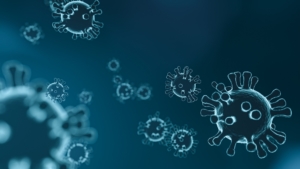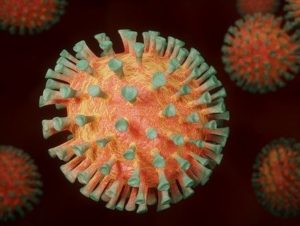Strategies to Eradicate Transmission of Poliovirus and Paralytic Poliomyelitis
Strategies to Eradicate Transmission of Poliovirus and Paralytic Poliomyelitis
March 23, 2022
Introduction
Polio (poliomyelitis) is a highly infectious disease that mostly affects children under 5 years of age. The causative agent, poliovirus, replicates in the gut but in some cases can invade the central nervous system and cause permanent paralysis (approximately one in 200 infections) or death (approximately 2-10% of paralyzed cases) (1). The virus is spread by person-to-person transmission by fecal-oral and oral-oral routes or, less frequently, by contaminated water or food. There are three individual and immunologically-distinct serotypes of wild poliovirus with multiple strains: wild polioviruses types 1, 2, and 3 (WPV1, WPV2, and WPV3) (2).
Since 1988, when the Global Polio Eradication Initiative (GPEI) was launched by WHO, the number of cases caused by wild polioviruses decreased by more than 99% through coordinated immunization and surveillance efforts (3). However, the ultimate goal of polio eradication by the year 2000 has not yet been reached. Polio is still endemic in Afghanistan and Pakistan, and importation of the virus can occur in other countries. Recently, Malawi detected a case caused by wild poliovirus, the first in Africa in more than five years. The strain detected in Malawi is linked to the one that has been circulating in Sindh Province in Pakistan. Currently, Malawi has scheduled a mass supplemental polio vaccination response targeting children under five, using the Bivalent Oral Polio Vaccine recommended by WHO and the Global Polio Eradication Initiative partners for WPV1 (2). All the neighboring countries – Mozambique, Tanzania and Zambia – have been alerted and are planning to conduct immunization campaigns.
GPEI Strategies
GPEI has implemented two strategies for the worldwide eradication of polio: maintaining strong population immunity levels through high vaccination coverage, and strong disease and environmental surveillance to rapidly detect and respond to polio (5). Currently, two types of vaccines are available: an inactivated poliovirus given by injection (IPV) and a weakened poliovirus given by mouth (OPV). These vaccines have contributed to the elimination of polio from most of the world. IPV is very safe and is the only polio vaccine that has been given in the United States since 2000 (6). OPV is still widely used in more than 140 low and middle-income countries for both routine immunization and mass vaccination campaigns. It is also safe but is associated with rare cases (one in a million) of vaccine-associated paralytic poliomyelitis (VAPP). In addition, live-attenuated Sabin poliovirus strains are excreted through feces and can spread in communities with inadequate sanitary conditions and population immunity. Their genetic instability leads to the reversion to neurovirulence and results in cases of paralytic poliomyelitis. Pathogenicity and transmissibility of these circulating vaccine-derived polioviruses (cVDPV) are indistinguishable from those of wild polioviruses. Thus, cVDPVs are a growing problem that threatens global eradication efforts (3). Further, certification of eradication of WPV2 in 2015 and the known risks of VAPP and cVDPV led to cessation of routine use of the type 2 component of Sabin OPV in 2016, with a coordinated switch from trivalent (types 1, 2 and 3) to bivalent OPV (types 1 and 3) in OPV-using countries (7, 8). It created substantial gaps in population immunity to type 2 poliovirus, triggering the emergence of cVDPV type 2 (cVDPV2). As a result, the number of cVDPV2 cases (mostly in Africa and Asia) increased from 2 in 2016 to more than 1,000 in 2020. During January 2020–June 2021, there were 38 independent outbreaks caused by cVDPV2 with active transmission in 34 countries, with 28 (82%) of these countries in Africa (9).
Polio (poliomyelitis) is a highly infectious disease that mostly affects children under 5 years of age. The causative agent, poliovirus, replicates in the gut but in some cases can invade the central nervous system and cause permanent paralysis (approximately one in 200 infections) or death (approximately 2-10% of paralyzed cases) (1).
GPEI has implemented two strategies for the worldwide eradication of polio: maintaining strong population immunity levels through high vaccination coverage, and strong disease and environmental surveillance to rapidly detect and respond to polio (5).
In response to cVDPV 2 outbreaks, rationally designed genetically stable strains of type 2 poliovirus were developed and used to create novel OPV2 (nOPV2) (10).
In response to cVDPV 2 outbreaks, rationally designed genetically stable strains of type 2 poliovirus were developed and used to create novel OPV2 (nOPV2) (10). Targeted genetic modification in the vaccine strain include a genetically stabilized domain V termed S15, which was designed to attenuate the strain to a similar degree as the Sabin strains, while avoiding the possibility of loss of attenuation via single nucleotide changes. Clinical studies in children aged 1 to 5 years confirm the superior genetic and phenotypic stability of shed nOPV2 strains compared to conventional Sabin OPV2 (13). Specifically, virus excreted by recipients of conventional OPV2 had A481G reversion in the primary attenuation site in domain V in the 5’ untranslated region, which was shown to be associated with increased neurovirulence. In contrast, stabilization of domain V in nOPV2 prevented this mutation, and excreted viruses did not show polymorphisms consistent with reversion to neurovirulence. Starting in early 2021, nOPV2 has been used under the WHO Emergency Use Listing (EUL) procedure in more than 100 million children and demonstrated superior genetic stability and safety (11, 12). Other vaccine platforms were also evaluated for the development of new safe and effective inactivated polio vaccines, including the use of virus-like particles and viral vectored vaccines (14, 15).
Conclusion
It is anticipated that next generation of vaccines inducing comprehensive immunity, without causing VAPP and cVDPVs, will soon become available. Achieving strong population immunity will efficiently prevent viral transmission and paralytic poliomyelitis. In addition, our efforts to detect viral transmission need to be strengthened by using surveillance for acute flaccid paralysis (AFP) followed by virological examination of all cases among children aged <15 years, as well as environmental surveillance by detecting polioviruses in sewage (16). COVID-19 pandemic mitigation measures have continued to limit AFP surveillance activities and laboratory testing (17). The continued strengthening of both surveillance systems, particularly in priority countries, is critical to tracking progress and documenting the absence of poliovirus transmission.
Our GVN Team thanks Dr. Konstantin Chumakov (Food and Drug Administration Office of Vaccine Research and Review) for reviewing this manuscript and for providing us with invaluable comments and insights.
References
- WHO. 2022. Wild poliovirus type 1 (WPV1) – Malawi. https://www.who.int/emergencies/disease-outbreak-news/item/wild-poliovirus-type-1-(WPV1)-malawi
- WHO. 2022. Malawi intensifies response after wild poliovirus detected. https://www.afro.who.int/countries/malawi/news/malawi-intensifies-response-after-wild-poliovirus-detected.
- Venkatesan P. Global polio eradication set back by COVID-19 pandemic. 2022. Lancet Microbe 3, E172, DOI:https://doi.org/10.1016/S2666-5247(22)00042-8
- WHO. 2022. Malawi declares polio outbreak. https://www.afro.who.int/news/malawi-declares-polio-outbreak.
- WHO. Poliomyelitis (polio). https://www.who.int/health-topics/poliomyelitis#tab=tab_1
- CDC. Polio Vaccination. https://www.cdc.gov/vaccines/vpd/polio/index.html
- Global Polio Eradication Initiative. Standard operating procedures. Responding to a poliovirus event or outbreak. Geneva, Switzerland: World Health Organization; 2020. https://polioeradication.org/wp-content/uploads/2020/04/POL-SOP-V3.1-20200424.pdf.
- Chumakov K, Ehrenfeld E, Agol VI, Wimmer E. Polio eradication at the crossroads. Lancet Glob Health. 2021 Aug;9(8):e1172-e1175. doi: 10.1016/S2214-109X(21)00205-9. Epub 2021 Jun 9. PMID: 34118192.
- Alleman MM, Jorba J, Henderson E, et al. Update on Vaccine-Derived Poliovirus Outbreaks — Worldwide, January 2020–June 2021. MMWR Morb Mortal Wkly Rep 2021;70:1691–1699.
- World Health Organization. Polio vaccine—novel oral (nOPV) monovalent type 2. Geneva, Switzerland: World Health Organization; 2020. https://extranet.who.int/pqweb/vaccines/polio-vaccine-novel-oral-nopv-monovalent-type-2.
- Wahid R, Mercer L, Macadam A, Carlyle S, Stephens L, Martin J, Chumakov K, Laassri M, Petrovskaya S, Smits SL, Stittelaar KJ, Gast C, Weldon WC, Konopka-Anstadt JL, Steven Oberste M, Van Damme P, De Coster I, Rüttimann R, Bandyopadhyay A, Konz J. Assessment of genetic changes and neurovirulence of shed Sabin and novel type 2 oral polio vaccine viruses. NPJ Vaccines. 2021 Jul 29;6(1):94.
- De Coster, I. et al. Safety and immunogenicity of two novel type 2 oral poliovirus vaccine candidates compared with a monovalent type 2 oral poliovirus vaccine in healthy adults: two clinical trials. Lancet 397, 39–50 (2021).
- Wahid, R., Mercer, L., Gast, C. et al. Evaluating stability of attenuated Sabin and two novel type 2 oral poliovirus vaccines in children. npj Vaccines 7, 19 (2022). https://doi.org/10.1038/s41541-022-00437-5.
- Fox H Knowlson S Minor PD Macadam AJ. Genetically thermo-stabilised, immunogenic poliovirus empty capsids; a strategy for non-replicating vaccines. PLoS Pathog. 2017; 13e1006117.
- Viktorova EG, Khattar SK, Kouiavskaia D, Laassri M, Zagorodnyaya T, Dragunsky E, Samal S, Chumakov K, Belov GA. Newcastle Disease Virus-Based Vectored Vaccine against Poliomyelitis. J Virol. 2018 Aug 16;92(17):e00976-18. doi: 10.1128/JVI.00976-18. PMID: 29925653; PMCID: PMC6096817.
- Tuma JN, Wilkinson AL, Diop OM, et al. Surveillance to Track Progress Toward Polio Eradication — Worldwide, 2019–2020. MMWR Morb Mortal Wkly Rep 2021;70:667–673.
- Zomahoun DJ, Burman AL, Snider CJ, et al. Impact of COVID-19 pandemic on global poliovirus surveillance. MMWR Morb Mortal Wkly Rep 2021;69:1648–52. https://doi.org/10.15585/mmwr.mm695152a4


